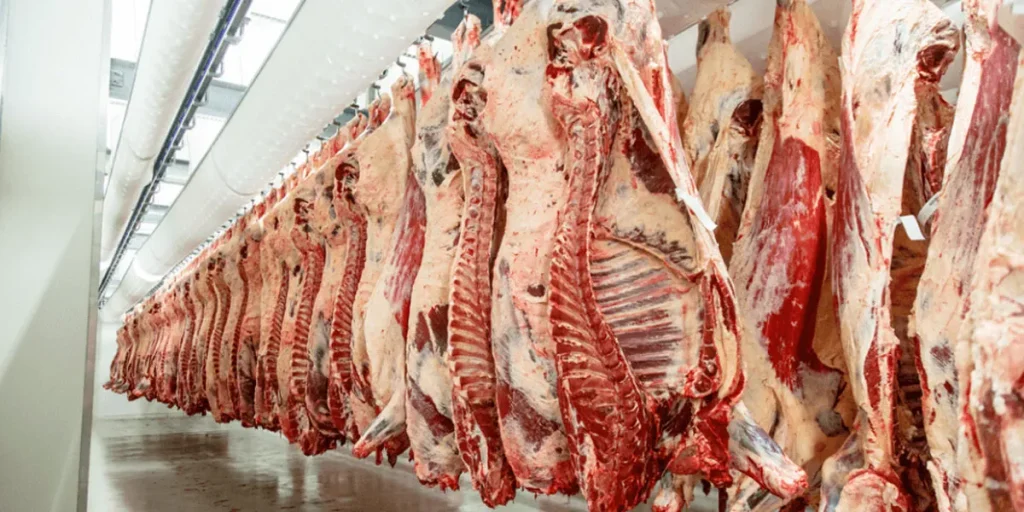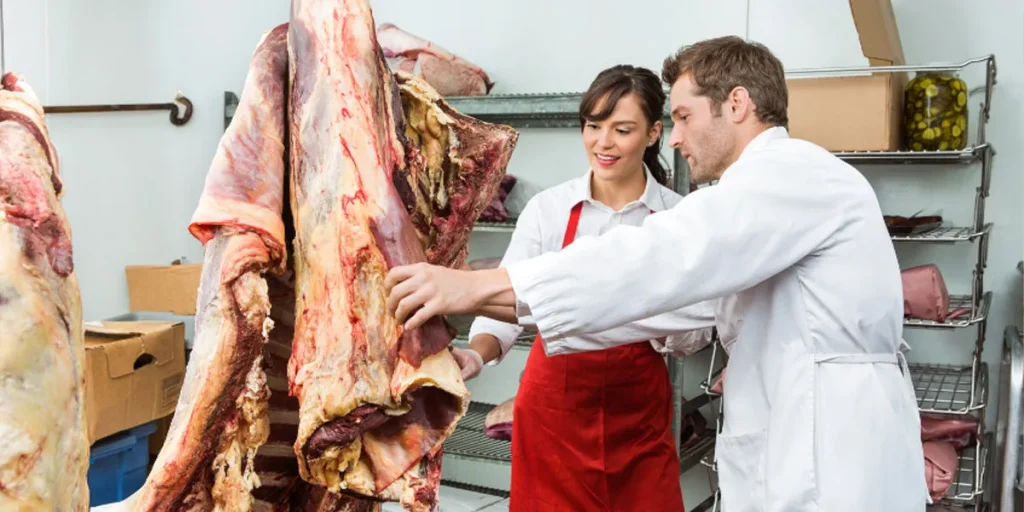A side of beef typically weighs between 150 and 250 pounds. This weight can vary depending on the size and breed of the cattle.
When considering purchasing a side of beef for your family or event, understanding the weight is crucial to estimating how much meat you’ll receive.
A side of beef, also known as a half beef, is essentially half of a whole carcass, divided down the spine, providing a balance of cuts ranging from steaks and roasts to ground beef and stew meat.
Purchasing in bulk like this can offer significant savings and ensures you know the source and quality of your meat.
It’s an ideal option for those looking to stock up their freezer with a variety of beef cuts for culinary uses.
Always remember that the actual weight will yield less in terms of consumable meat due to the dressing percentage, which includes bone and fat loss during processing.
Weighing In On Side Of Beef
Understanding the heft of beef can guide you through purchasing decisions and meal planning.
Let’s dive into the world of beef, breaking down the average weights by cut and the factors that influence these numbers.
Whether you’re a family looking for a bulk purchase or a chef curating a menu, knowing these details ensures you get the right amount of beef for your needs.
Average Weights By Cut
Beef is typically divided into various cuts, each with its own standard weight. These weights can help you predict how much meat you’ll receive from a side of beef.
| Cut of Beef | Average Weight |
|---|---|
| Ribeye Steaks | 11-14 lbs |
| T-Bone Steaks | 6-8 lbs |
| Ground Beef | 50-100 lbs |
| Roasts | 14-20 lbs |
| Stew Meat | 5-7 lbs |
| Sirloin Steaks | 8-10 lbs |
Factors Influencing Weight
A side of beef’s weight is not a fixed number. It varies due to several factors:
- Breed: Different breeds yield different amounts of meat.
- Age: Older cattle generally have more meat.
- Gender: Steers (castrated males) usually have more meat than heifers (females).
- Feed: Grass-fed versus grain-fed diets can affect weight.
- Butchery: The skill of the butcher can minimize waste.
Cut To The Chase: Understanding Beef Cuts

Cut to the Chase: Understanding Beef Cuts is more than butcher’s lingo – it’s your guide to gastronomic brilliance.
A side of beef may tip the scales at anywhere between 150 to 250 pounds, depending on the cow’s breed and butchering style.
To navigate this hefty investment, knowing the beef cuts is crucial. Each cut varies in flavor, tenderness, and cook time. So, grab a steak knife and let’s carve into the meaty details.
Prime Cuts And Their Impact
Steaks from these regions grace fine dining menus. Prime cuts are known for marbling, tenderness, and robust flavors. Here’s a quick look:
- Ribeye: Juicy with generous marbling.
- Tenderloin: Lean and exquisitely tender.
- Sirloin: Versatile with a balance of leanness and flavor.
- T-Bone: A steak lover’s favorite, rich and hearty.
These cuts often fetch a higher price. They’re also perfect for grilling, searing, and broiling.
Lesser-known Cuts Explained
Every piece of beef has potential – especially the lesser-known cuts. They may require more cooking finesse but are equally delightful:
| Cut | Characteristics | Best Cooking Method |
|---|---|---|
| Chuck | Affordable and flavorful. | Slow cooking, braising. |
| Brisket | Tough but tasty. | Brisket loves a low-and-slow roast. |
| Skirt | Thin, with bold beefiness. | Quick sear, keeps it juicy. |
| Flank | Lean, with a strong grain. | Marinate, then grill or broil. |
These hidden gems are not only cost-effective but provide a canvas for culinary creativity. They challenge and reward the patient cook with rich, deep flavors.
The Scale Of Beef Buying

Understanding the weight of a side of beef simplifies buying decisions. Consumers often purchase beef in bulk to save money and enjoy a variety of cuts.
A side of beef, also known as a half-cow, varies in weight. On average, it tips the scales between 300 to 400 pounds.
Buying In Bulk: Pros And Cons
Pros:
- Cost Savings: Buying a side of beef typically has a lower price per pound compared to individual cuts.
- Quality Control: You know precisely where your beef comes from and how it was processed.
- Variety: Enjoy different cuts perfect for grilling, roasting, or slow cooking.
Cons:
- Storage Space: You need a large freezer to store hundreds of pounds of beef.
- Upfront Cost: The initial investment is significant, even though it saves money over time.
- Flexibility: You commit to eating beef for an extended period.
Cost Per Pound Breakdown
The price for a side of beef varies. Factors include the farm’s practices, beef grade, and location. The table below offers a sample breakdown:
| Cut of Beef | Average Weight | Cost Per Pound |
|---|---|---|
| Ground Beef | 50 lbs | $5.00 |
| Steak Cuts | 100 lbs | $10.00 |
| Roasts | 80 lbs | $7.50 |
| Other Cuts | 70 lbs | $6.00 |
Remember, the total cost includes processing fees. These fees vary but expect to pay between $0.50 to $1.00 extra per pound. Planning and budgeting become easier with this understanding.
From Pasture To Plate
Understanding the journey of beef from pasture to plate enriches the appreciation for your meal.
Before a side of beef graces your table, numerous factors influence its weight and quality. This includes the diet of the cattle and the processing techniques used post-harvest.
Grain Vs. Grass-fed Differences
The diet of cattle plays a crucial role in the final weight of a side of beef. Grain-fed and grass-fed beef differ significantly:
- Grain-fed beef typically comes from cattle that eat a diet of grains and supplements. This diet hastens growth, resulting in a heavier side of beef.
- Grass-fed cattle graze on pasture and may have a leaner composition. While this might lead to a lighter side of beef, many prize it for its nutritional profile.
| Type of Feed | Weight Impact | Nutritional Profile |
|---|---|---|
| Grain-fed | Heavier | Higher Fat Content |
| Grass-fed | Lighter | More Omega-3 Fatty Acids |
The Process Of Aging Meat
Meat aging is another vital step after cattle come from the pasture. This process improves the texture and flavor of beef. Here’s what happens:
- After harvest, beef is hung or placed on racks. This starts the aging process.
- Enzymes work on the meat, breaking down muscle tissue. This results in tenderness.
- Dry aging allows meat to lose moisture. It concentrates the flavor but also reduces weight.
A side of beef can lose up to 15% of its weight during aging. The length and method of aging change the final weight and culinary experience.
Storage And Shelf Life Hurdles
Purchasing a side of beef is an excellent investment for meat lovers. Understanding storage and shelf life is critical to making the most of this bulk purchase.
The right preparation steps ensure the meat remains fresh, safe, and palatable for as long as possible.
Freezer Space Necessities
Before bringing home a side of beef, assessing freezer space is essential. On average, a half cow can weigh between 200 to 250 pounds of packaged meat.
Most freezers in a typical household aren’t equipped to handle this bulk. Hence, preparing adequate space is key.
Consider these points for freezer preparation:
- A standalone deep freezer works best.
- Ensure at least 14 cubic feet of space for half a cow.
- Organize with labels and dates for ease of use.
Optimizing Meat Longevity
Maximizing the shelf life of beef involves proper packaging and temperature control. The goal is to prevent freezer burn and bacterial growth. Below are strategies to optimize meat longevity:
| Strategy | Details |
|---|---|
| Vacuum Sealing | Removes air and seals in freshness. |
| Consistent Temperature | Maintain a steady 0°F (-18°C) or lower. |
| Rotation System | Use older items first to keep stock fresh. |
Beef properly frozen and stored can last several months to a year. Individual cuts have varying shelf lives:
- Steaks maintain quality for 6 to 12 months.
- Ground beef is best used within 4 months.
- Roasts can stay top-notch for up to a year.
Remember, organized storage leads to longer-lasting, delicious beef.
FAQs About the Weight of a Side of Beef
What Is A Standard Side Of Beef Weight?
A typical side of beef, also known as a half beef, weighs approximately 250 to 300 pounds.
This weight can vary based on the breed, age, and feed of the cattle.
How Many Cuts From A Side Of Beef?
From a side of beef, you can expect a variety of cuts including about 12-14 steaks, 10-12 roasts, 15-20 pounds of ribs, and 50-60 pounds of ground beef.
The actual number of cuts may vary based on the carcass size and butchering preferences.
Can You Buy A Half Side Of Beef?
Yes, purchasing a half side of beef is a common option for many consumers.
It allows you to stock your freezer with a wide range of beef cuts at a potentially lower cost per pound.
What Factors Affect Beef Side Weight?
Factors influencing the weight of a side of beef include the cattle’s breed, the feed they’ve consumed, their age at slaughter, and the butchering process used.
Each factor contributes to the overall yield and size.
Conclusion
To sum it up, a side of beef typically ranges from 150 to 250 pounds. Each cut from this significant amount can cater to various meal preparations, offering both versatility and value. Remember, factors like the breed, age, and feed play pivotal roles in the final weight.
Smart planning and understanding your needs ensure you make the most of your purchase. Choose wisely to enjoy a bounty of beefy delights!
Resources:
https://www.fsis.usda.gov/food-safety/safe-food-handling-and-preparation/meat-fish/beef-farm-table
https://www.federalregister.gov/documents/2023/11/06/2023-24395/beef-promotion-and-research-order-reapportionment-and-technical-amendment
